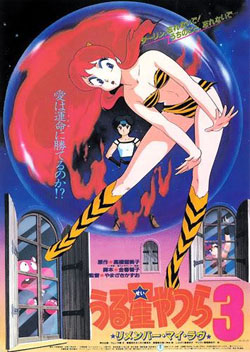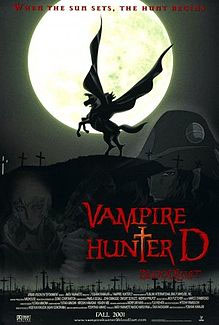Fooled you! I am not through yet. Particularly since I have been encouraged to keep this topic going.
Picking my Top Ten anime choices was a tough decision. I narrowed my pick of the Top Ten anime features – my ten favorites, anyway – down to the Top Fifteen fairly easily; but I kept dithering after that, arranging and rearranging them. Finally, I made two decisions. Firstly, I dropped all other Miyazaki titles. If I didn’t, I risked having my Top Ten be all Miyazaki features. Secondly, I finalized my Top Ten, plus the next five runner-ups since they were so close. Here are the first three of those, also in chronological order.
 11. Urusei Yatsura 3: Remember My Love. Produced by Studio Deen. Directed by Kazuo Yamazaki. 91 minutes. January 26, 1985.
11. Urusei Yatsura 3: Remember My Love. Produced by Studio Deen. Directed by Kazuo Yamazaki. 91 minutes. January 26, 1985.
Urusei Yatsura was first a manga by Rumiko Takahashi. It became an anime fan favorite from almost the first moment that it appeared in TV in 1983, with TV episodes, theatrical features, and Original Anime Videos for almost the next ten years.
Everyone had a different favorite. Mine was the third theatrical feature. A witch is apparently not invited to Lum-chan’s birth celebration in 1967, and curses her to unrealized love with her true “darling”. Ruu, a lonely teenager in 2267, falls in love with Lum’s picture in a crystal ball, time-travels to 1985 when she is 18 years old, and, disguised as a clown at “Märchenland”, uses “futuristic technology” magic to confound her friends and turn Ataru, her true love, into a pink hippopotamus, so she will be free to devote all her attention to him.
Of course, Lum remains true to Ataru. Urusei Yatsura 3 has the attractions of the Disneylandish Märchenland, all of the characters in the series (of course), one of the best animated sequences in any UY title (the furious Lum’s flying chase of Ruu past windowed skyscrapers), very good music by Mikki Yoshino, and for me, anthropomorphic animals: Ataru as a pink hippopotamus, Ruu’s tanuki assistant Oshima, and Alice in Wonderland’s White Rabbit in a bit part.
12. Blood: The Last Vampire. Produced by Studio I.G. Directed by Hiroyuki Kitakubo. 45 minutes. July 29, 2000.
 An excellent modern urban vampire horror thriller. This is another Mamoru Oshii creation. He wrote the concept to be developed in three formats, each of which added something that was missing from the others to tell the complete story. The 45-minute anime feature, set in 1966, was the first; a novel trilogy published between October 2000 and July 2001, the first by Oshii and the other two by Junichi Fujisaku, was next; and a video game, created by Studio I.G and Sony Computer Entertainment Japan, set in 2000 and released in December 2000, completed the trilogy. The video game was rereleased in 2006, and the short anime feature was rewritten into a 2009 91-minute live-action horror movie. The original anime movie played the international film feature circuit during its first year, winning many awards. According to Wikipedia, “In the first week of its North American (video) release, more than 70,000 DVDs and 30,000 VHS copies of Blood: The Last Vampire had been sold.”
An excellent modern urban vampire horror thriller. This is another Mamoru Oshii creation. He wrote the concept to be developed in three formats, each of which added something that was missing from the others to tell the complete story. The 45-minute anime feature, set in 1966, was the first; a novel trilogy published between October 2000 and July 2001, the first by Oshii and the other two by Junichi Fujisaku, was next; and a video game, created by Studio I.G and Sony Computer Entertainment Japan, set in 2000 and released in December 2000, completed the trilogy. The video game was rereleased in 2006, and the short anime feature was rewritten into a 2009 91-minute live-action horror movie. The original anime movie played the international film feature circuit during its first year, winning many awards. According to Wikipedia, “In the first week of its North American (video) release, more than 70,000 DVDs and 30,000 VHS copies of Blood: The Last Vampire had been sold.”
Saya, who looks like a school-uniformed teenage student with a katana, is a 400-year-old human-vampire hybrid with super-strength and a perpetually angry attitude. She works with the top-secret “Red Shield”, apparently a U.S. government or military agency, to hunt down and kill the chiropterates, the full vampires who are ferocious flying monsters that can shape-shift into apparent humans. Saya is introduced on a Toyko subway, killing a normal man whom she insists is a disguised chiroptera. Her U.S. “handlers”, David and Louis (a Black man), arrive. Louis thinks that she has killed an innocent man, but they are ultimately forced to take her word for it. Clues lead to nearby U.S. Yokota Air Base, which is being built up for the Vietnam war. Red Shield suspects that the chiropterates are gathering there to prey on both the American soldiers and their civilian families, disguised as either Japanese call girls just outside the base and as students at the base high school. Saya enters posing as a Japanese schoolgirl during the Air Base’s Halloween festivities, and quickly runs into more trouble than she can handle. Her secret battle with the chiropterates is witnessed only by the terrorized middle-aged base head nurse, Mahiko Amano, who looks on with horror as the chiropterates reveal their true forms and Saya and David battle them. When the next morning comes, Saya and David are gone and nobody believes Mahiko’s story.
The plot is suspensefully developed and excellently choreographed. A very nice touch is, for the American and British release, having the Americans speak in English and the Japanese in Japanese subtitled in English. For the Japanese release, this was reversed; the Japanese speak Japanese and the Americans speak English subtitled in Japanese.
13. Vampire Hunter D: Bloodlust. Produced by Studio Madhouse. Directed by Yoshiaki Kawajiri. 105 minutes. August 25, 2000.
An excellent traditional fantasy vampire horror thriller, although it is set around 12,090 A.D., after civilization has been destroyed and re-evolved. For many centuries, a vampire aristocracy of Nobles has preyed on human commoners and serfs, although the humans have begun to throw off their vampire overlords. D, a half-human half vampire “dhampir”, is an immortal wandering mercenary, hiring himself out to humans who need help fighting their vampire masters. In the novel series (twenty-six so far) by Hideyuki Kikuchi, D is rumored to be an unacknowledged son of Count Dracula, who is revered by the vampires as a god.
 Vampire Hunter D: Bloodlust was the second anime feature based upon the series; the first, titled simply Vampire Hunter D, was released in 1985. It was denigrated by Kikuchi as of low-quality, but it was more popular in the U.S. than in Japan. The fans demanded a sequel, Kikuchi demanded that it be of higher quality, and finally a Japanese entrepreneur in the U.S., Mataichiro Yamamoto, who had just established the Urban Vision anime video company, undertook to fund its production as a top-quality limited-release theatrical feature for the more valuable general home-video rights.
Vampire Hunter D: Bloodlust was the second anime feature based upon the series; the first, titled simply Vampire Hunter D, was released in 1985. It was denigrated by Kikuchi as of low-quality, but it was more popular in the U.S. than in Japan. The fans demanded a sequel, Kikuchi demanded that it be of higher quality, and finally a Japanese entrepreneur in the U.S., Mataichiro Yamamoto, who had just established the Urban Vision anime video company, undertook to fund its production as a top-quality limited-release theatrical feature for the more valuable general home-video rights.
Vampire Hunter D: Bloodlust is based on Kikuchi’s third novel in the series, Demon Deathchase (1985). Charlotte, a beautiful human girl, is kidnapped by vampire nobleman Baron Meyer Link. Charlotte’s father hires D to find them and bring Charlotte home; but if D discovers that Charlotte has been bitten and turned into a vampire, he is to kill her humanely. But Charlotte’s brother hires the Marcus family (four brothers and sister Leila) of vampire hunters to also find her, as backup. D knows that the Marcus family is ruthless, with a reputation of killing its competition as well as its vampire. Also, with Charlotte’s family paying equally for her return or her death if she is now a vampire, it will be easier for the Marcuses to kill her and claim that she had become a vampire.
As the chase continues, Meyer Link hires supernatural allies to stop any pursuit. D must battle them as well as the Marcuses. Complications are that D discovers that Leila and one of her brothers are misguided but not evil, and that Charlotte may have gone voluntarily with Meyer Link, her lover, who apparently is genuinely devoted to her.
Urban Vision commissioned Madhouse, one of the top anime studios in Japan, with its leading director, Yoshiaki Kawajiri, to art-design and direct Vampire Hunter D: Bloodlust. It was voice-recorded in Hollywood in English for the American theatrical and video release, and shown in Japan in English with Japanese subtitles. Mataichiro Yamamoto and Urban Vision were pleased with the result. Hideyuki Kikuchi was pleased. The Vampire Hunter D fans in both America and Japan were pleased. And I was so pleased that it has ended up on this list.
Next week: 14 & 15.


 Fred Patten (1940-2018) was an internationally respected comics and animation historian. He has written about anime or comic books for publications ranging from Animation Magazine and Alter Ego to Starlog. He was a contributor to The Animated Movie Guide (2005), and is author of Watching Anime, Reading Manga (2004, Stone Bridge Press), a collection of his best essays, and Funny Animals and More (2014, Theme Park Press), based upon his early columns here on Cartoon Research. He passed away on November 12th, 2018.
Fred Patten (1940-2018) was an internationally respected comics and animation historian. He has written about anime or comic books for publications ranging from Animation Magazine and Alter Ego to Starlog. He was a contributor to The Animated Movie Guide (2005), and is author of Watching Anime, Reading Manga (2004, Stone Bridge Press), a collection of his best essays, and Funny Animals and More (2014, Theme Park Press), based upon his early columns here on Cartoon Research. He passed away on November 12th, 2018.





































Leave a Reply